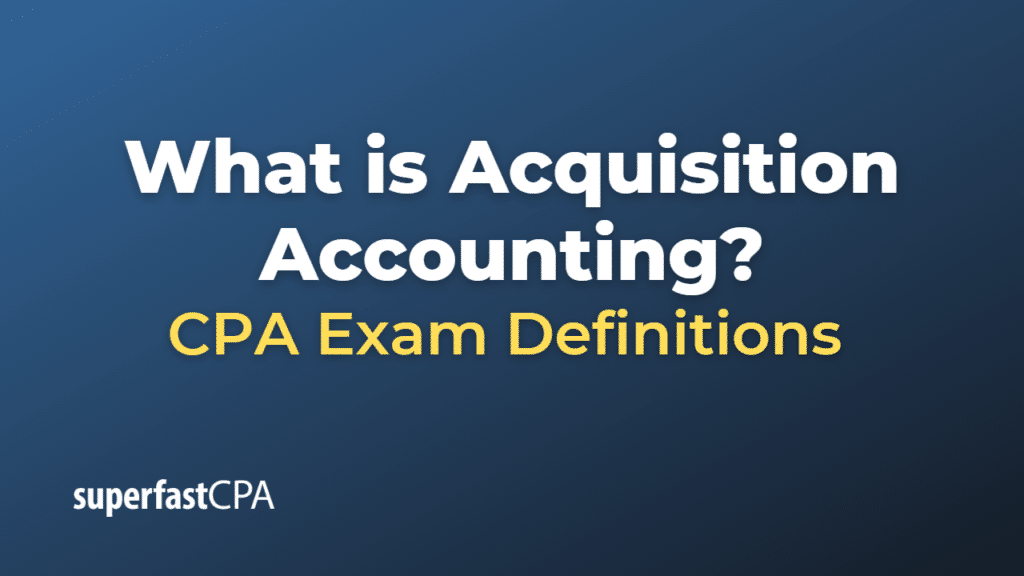Acquisition Accounting
Acquisition accounting is a method used to record the financial transactions and adjustments related to a business combination or acquisition. It is based on the acquisition method, which is prescribed by the accounting standards such as US GAAP (Generally Accepted Accounting Principles) and IFRS (International Financial Reporting Standards). The acquisition method involves the following key steps:
- Identifying the acquirer: Determine which company is the acquiring entity in the business combination.
- Measuring the acquisition cost: Calculate the fair value of the consideration given by the acquirer, which can include cash, equity, or other assets, as well as any contingent consideration.
- Recognizing and measuring the acquiree’s identifiable assets, liabilities, and contingent liabilities: Determine the fair value of the acquiree’s assets and liabilities at the acquisition date. This may require adjusting the acquiree’s historical carrying values to reflect their fair market values.
- Recognizing and measuring goodwill or a gain from a bargain purchase: Calculate the difference between the acquisition cost and the net fair value of the acquiree’s identifiable assets and liabilities. If the acquisition cost is higher, the difference is recorded as goodwill, an intangible asset. If the acquisition cost is lower, the difference is recognized as a gain from a bargain purchase.
- Consolidating financial statements: Combine the acquirer’s and acquiree’s financial statements to present the financial results of the combined entity. This involves eliminating any intercompany transactions and balances between the acquirer and the acquiree.
Acquisition accounting aims to provide a clear and accurate picture of the financial position and performance of the combined entity following a business combination, ensuring that the financial statements reflect the fair values of the acquired assets and liabilities, and any goodwill or bargain purchase gain arising from the transaction.
Example of Acquisition Accounting
Let’s consider a simplified example of acquisition accounting. Company A acquires Company B for $1,000,000 in cash. Here’s the balance sheet data for both companies before the acquisition:
Company A:
- Cash: $1,500,000
- Buildings: $2,000,000
- Total assets: $3,500,000
- Liabilities: $1,000,000
- Equity: $2,500,000
Company B:
- Cash: $200,000
- Buildings: $1,000,000
- Inventory: $300,000
- Total assets: $1,500,000
- Liabilities: $500,000
- Equity: $1,000,000
After the acquisition, the fair values of Company B’s assets and liabilities are as follows:
- Cash: $200,000
- Buildings: $1,200,000 (an increase in fair value by $200,000)
- Inventory: $350,000 (an increase in fair value by $50,000)
- Total assets: $1,750,000
- Liabilities: $500,000
Now, let’s apply the acquisition accounting method:
- Identify the acquirer: Company A is the acquirer.
- Measure the acquisition cost: Company A paid $1,000,000 in cash for Company B.
- Recognize and measure the acquiree’s identifiable assets, liabilities, and contingent liabilities at fair value:
- Company B’s assets have a fair value of $1,750,000.
- Company B’s liabilities remain at $500,000.
- Recognize and measure goodwill or a gain from a bargain purchase:
- The acquisition cost is $1,000,000.
- The net fair value of Company B’s identifiable assets and liabilities is $1,750,000 – $500,000 = $1,250,000.
- The difference between the acquisition cost and the net fair value is $1,000,000 – $1,250,000 = -$250,000. This indicates a gain from a bargain purchase.
- Consolidate financial statements:
Post-acquisition balance sheet of Company A (the combined entity):
- Cash: ($1,500,000 – $1,000,000) + $200,000 = $700,000
- Buildings: $2,000,000 + $1,200,000 = $3,200,000
- Inventory: $350,000
- Total assets: $4,250,000
- Liabilities: $1,000,000 + $500,000 = $1,500,000
- Equity: $2,500,000 + $1,000,000 = $3,500,000
- Gain from bargain purchase: $250,000
Total equity and liabilities: $1,500,000 (liabilities) + $3,500,000 (equity) + $250,000 (gain from bargain purchase) = $4,250,000
In this example, Company A’s acquisition of Company B resulted in a gain from a bargain purchase due to the fair value of Company B’s identifiable assets exceeding the acquisition cost. The post-acquisition balance sheet of the combined entity reflects the updated values for cash, buildings, inventory, and the gain from the bargain purchase.













